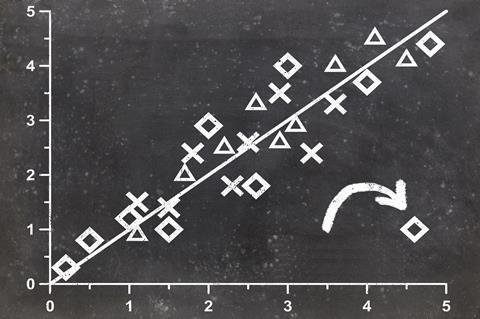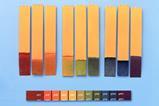Use scenarios to help structure how your pupils explain anomalies
There is a cultural issue with practical work. Pupils may enjoy it because of the greater freedom it affords, but struggle to see its purpose in the classroom beyond gaining experimental results. Pupils commonly skip over the practical pages in their exercise books when revising, concentrating only on the theory.
This is now an especially important problem in England as the new GCSEs assess understanding of practical chemistry in the main exam papers. Gone are the many iterations of coursework and the separation of the skills of planning, interpretation and evaluation into a defined part of the assessment.
Questions about experimental work are difficult because they often bring together many strands of chemistry and apply them to a practical situation. The practical situations are likely to be similar to those encountered during the ‘required’ practicals but aren’t exactly the same. Rote learning of standard procedures won’t do; the examiners are smarter than that!
So how can you help students understand practical work and answer the practically focused questions in exams?

Beyond human error
One aspect of practical work that exams questions might probe is anomalous results. Questions might be: What caused the anomalous result? or Suggest a reason to explain the anomalous result.
Pupils’ default answer is human error. This is never sufficient and pupils need to think of other reasons. It is important to be specific and explain why the anomalous result is higher or lower than the expected result. This can be difficult for pupils: they need to understand how the nature of the experimental procedure and the apparatus influence the measurements taken.
Make it a routine
It is easy to squeeze the evaluative part of experimental work out when lesson time is limited. Also, pupils may purposely dawdle over their practical work to delay the part of the lesson where they have to write. A lack of emphasis on evaluation means pupils aren’t used to thinking carefully about the limitations of their practical work and the reasons why measurements might be higher or lower than expected.
One way to routinely practice evaluation is to present pupils with a range of carefully considered scenarios for an experiment. Ask them to consider the effect of each scenario on the results. Results could be measurements or observations. Present the scenarios in a tick box grid. Reduce individual workload and encourage collaborative planning by designing grids in a staff meeting.
In example 1, pupils consider how the final mass of product changes for different scenarios when students heat magnesium in air in a crucible.
Example 1: Consider the following scenarios and how they would affect the final mass of the product and crucible. Would the students get a larger, the same, or a smaller mass than they expected? Tick the appropriate box and be prepared to justify your answer.
| What happens to the final mass of the product and crucible if … | More | Same | Less |
|---|---|---|---|
|
The students put a lid on the crucible |
|||
|
The students prodded the magnesium oxide with a splint |
|||
|
The students didn’t tare the balance correctly before weighing the magnesium and crucible |
|||
|
The students coiled the magnesium too tightly |
Focus on reasoning
The question’s tick-box nature makes it accessible for younger age groups and lower achievers, building confidence through discussion. The discussion can then lead into written answers. Class discussion as a plenary or at the start of the following lesson explores pupils’ reasoning for their ticks. For some scenarios there is a correct answer while for others it is less clear. Getting the correct answer is less important than sensible reasoning.
For example, for the scenario: ‘The students prodded the magnesium oxide with a splint’, any answer could be correct. All of the following reasoning is sensible:
- More – a bit of the splint broke off into the crucible, adding to the mass
- Same – the splint didn’t affect the magnesium oxide, none was transferred onto it and no bits of the splint came off
- Less – Some magnesium oxide was transferred to the splint so there was less in the crucible
Younger and less confident pupils could write one or two bullet points from each scenario following this discussion. Older pupils could write out their reasoning in full for you to also assess language.
Example 2 probes students’ understanding of standard scale preparation of copper sulfate crystals from excess copper oxide and sulfuric acid.
Example 2: Consider the following scenarios and decide whether they would lead to more, the same, or less copper sulfate product being formed. Put a tick in the relevant box and be prepared to discuss your answer.
| What happens to the amount of copper sulfate formed if … | More | Same | Less |
|---|---|---|---|
|
The measuring cylinder was washed out before the experiment and not dried |
|||
|
Copper oxide was added only until the solution went a clear blue |
|||
|
The crystals weren’t left on the windowsill long enough before being weighed |
|||
|
The filtered solution was heated too strongly in the evaporating basin |
|||
|
The mixture wasn’t left to filter for long enough |
|||
|
The copper oxide used was impure |
Revisit and build upon this routine work in assessments that include questions requiring a written answer and explanation for an anomalous result. This little and often approach helps students think more deeply about their practical work and how results can be influenced by the action of the experimenter or the apparatus.
Downloads
Anomalous results: questions
Word, Size 57.86 kbAnomalous results: questions
PDF, Size 54.97 kbAnomalous results: answers
Word, Size 58.54 kbAnomalous results: answers
PDF, Size 58.36 kb















No comments yet